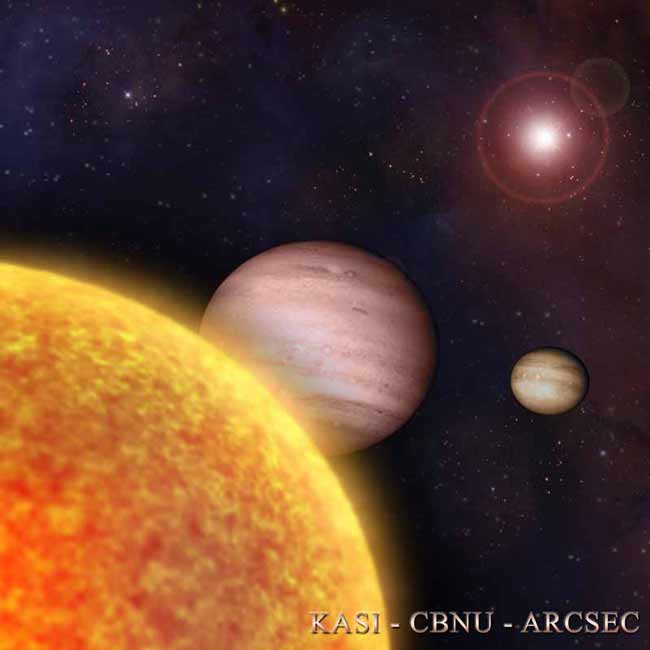Solar System Like Ours Found

The discovery of a Jupiter-like planet and another about the size of Saturn has astronomers suggesting that solar systems like our own may be common.
The newfound worlds both appear to be gaseous and are about 80 percent the sizes of Jupiter and Saturn, the astronomers said today. They orbit a star that is about half the size of our sun and is dimmer and much cooler.
“This is the first discovery of a multi-planet system that could be analogous to our solar system,” said research team member Alison Crocker, a Dartmouth College graduate now studying at Oxford University.
Several similarities
The newfound solar system, about 5,000 light-years away, is more compact than our own. The larger planet's orbit is 2.3 times as far from its host star as the Earth is from the sun. Jupiter is 5.2 times farther from the sun than Earth.
But there are several interesting similarities:
- The ratio between the masses of the two worlds is about 3:1, similar to the Jupiter/Saturn ratio.
- The smaller planet is about twice as far from its star as the larger one, just as Saturn is roughly twice as far away from the sun as Jupiter.
- The two worlds orbit their star in 5 and 14 years, similar to the 2:5 orbit ratio of Jupiter and Saturn.
The planets were found using a technique called gravitational lensing, in which light from the faraway planets is bent and magnified by the gravity of a foreground object, in this case a another star. The technique has been used to find three other Jupiter-mass planets, each around different stars, in the past.
Breaking space news, the latest updates on rocket launches, skywatching events and more!
"This is the first time we had a high-enough magnification event where we had significant sensitivity to a second planet — and we found one," said Scott Gaudi, assistant professor of astronomy at Ohio State University. "You could call it luck, but I think it might just mean that these systems are common throughout our galaxy."
The discoveries, by an international team using 11 telescopes around the world, are detailed in the Feb. 15 issue of the journal Science. The initial observations were made by The Optical Gravitational Lensing Experiment (OGLE).
Formation theories
Even though their star emits only about 5 percent as much light as the sun, the two planets, namded OGLE-2006-BLG-109Lb and OGLE-2006-BLG-109Lc, are thought to be about the same temperatures as Jupiter and Saturn because of their tighter orbits.
“The temperatures are important because these dictate the amount of material that is available for planet formation,” Gaudi said. “Most theorists think that the biggest planet in our solar system formed at Jupiter's location because that is the closest to the sun that ice can form. Saturn is the next biggest because it is in the next location further away, where there is less primordial material available to form planets.”
Theorists have wondered if gas giants in other solar systems form in the same way as ours did.
"This system seems to answer in the affirmative," Gaudi said.
The leading theory is that a rocky protoplanet forms first, then if it gains enough mass, it attracts a shell of gas. Astronomers don't agree, however, whether that explains all the giant planets in our solar system. Another idea is that the giants collapse from a knot of material, much in the way a star forms.
Other worlds?
It's also plausible that there could be rocky planets around the star in orbits similar to Venus, Earth or Mars. And icy worlds like Neptune might exist in the system's outer reaches, the researchers said.
There are now about 250 known planets beyond our solar system and some 25 multiple-planet system. Among those are setups with rocky worlds just a few times the mass of Earth.
"While most planetary systems around other stars substantially differ from [our] solar system, a series of recent detections have brought us closer and closer to home," said Martin Dominik, a University of St. Andrews researcher involved in the discoveries. "Sooner rather than later, someone can be expected to discover an Earth-mass planet orbiting a star other than the sun."
- Video: Planet Hunters
- Top 10 Most Intriguing Extrasolar Planets
- Nearby Solar System Looks Like Home

Rob has been producing internet content since the mid-1990s. He was a writer, editor and Director of Site Operations at Space.com starting in 1999. He served as Managing Editor of LiveScience since its launch in 2004. He then oversaw news operations for the Space.com's then-parent company TechMediaNetwork's growing suite of technology, science and business news sites. Prior to joining the company, Rob was an editor at The Star-Ledger in New Jersey. He has a journalism degree from Humboldt State University in California, is an author and also writes for Medium.
